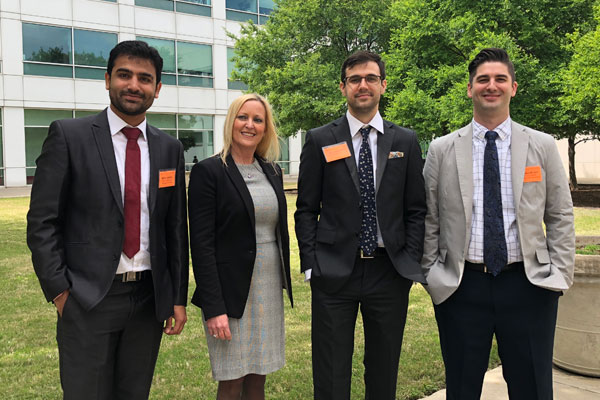
Step 10: Maintain your commitment and protect your professional image.

Student Code of Conduct and Ethics Policy for Employment and Recruitment
Understand the consequences for failure to follow this policy.
CMC Student Testimonials

Adrienne Large
Bachelor’s in Marketing – Senior
I experienced how the CMC loves to help students who have caught the vision for excellence by providing networking opportunities and introductions to recruiters. I credit the external, paid internship I landed later to showing up, engaging, and soaking up their invaluable coaching!

SeoYeon (Soy) Choi
Master’s in Information Technology Management, Class of ’21
Be prepared to allocate few hours a day to mold your cover letter to fit your dream companies. Start early, apply to many, and importantly, set your boundaries – focus on specific job title(s).

Asm Rahman, MS in Business Analytics
Master’s in Business Analytics, Second Year
Be prepared to allocate few hours a day to mold your cover letter to fit your dream companies. Start early, apply to many, and importantly, set your boundaries – focus on specific job title(s).

Bhushan Sonmale, Class of ’21
Master’s in Information Technology Management, Class of ’21
Enrolling in the Professional Development course (MAS 6102) at UT Dallas was one of the best things that happened to me at the start of my Master’s journey.
FAQs – CMC Student Resources
Here are a few examples of when to research:
- When you are starting your job search and looking for key companies in your profession or geographic location
- During the application process, you want to be able to tailor your cover letter and resume to each place you apply
- When you have been invited to interview, you will want to be able to clearly talk about an employer’s market, competitors, culture and what skills you can bring to the company. Lastly, your research will help you formulate a few good questions for the employer in the interview when they ask, “what questions do you have for me?”
It is always recommended that you negotiate because employers expect you to negotiate. Remember to do your research on what is typical in your field with your experience level and know what you are worth based on your skills that you bring. In addition, understand the total compensation package. You will negotiate using this information, not simply just asking for more money.
Let the employer know that you are really happy that they offered and that you will closely review all of the information and get back to them by the deadline.
You will only get one counteroffer – that is the employer makes you an offer, you will make a counteroffer and they will come back to you with their final offer. At that point you have a decision to make as to whether you accept the position, but you will not try to counter their final offer.
- LaunchMyCareertx.org
- Glassdoor.com
- Indeed.com/salary
- PayScale.com
- Salary.com
- BLS.gov
- LinkedIn Network
When the employer says “we would like to offer you the job” and does not indicate how much they will pay you will need to clarify it before the negotiation can move forward. For example: I’m very excited about the position and know that I’d be the right fit for the team. I’m also happy about knowing that I’ll bring a lot of value to the job. What salary are you offering?
The average intern salary for undergraduates is $10 – $20 per hour. Graduate students averages$15-$25 per hour. It is not uncommon for non-profit and healthcare organizations to offer unpaid internships.
Consider what you will learn, how this will add to your base of experience for your resume and next job opportunity, and remember that for healthcare and non-profits unpaid internships are common. You have to weigh out if an unpaid internship is a benefit to you in the long run or if you should continue to pursue a paid opportunity.
A panel interview includes meeting with 2 or more individuals from a company at the same time. Companies sometimes do this to save time and ensure that all interested parties have a chance to meet you and learn about your qualifications. You must practice your behavioral interviewing and professionalism skills in order to be fully prepared. Register for one of our workshops in Handshake, or set up a 1-1 appointment with a JSOM CMC Career Development Specialist.
Virtual interviewing can be live or “on-demand” (recorded), and when you’re invited to complete one, the company will typically include instructions. Make sure you have a high quality camera and microphone, and be prepared to wear a business suit. Utilize the InterviewStream tool to practice behavioral interview questions, register for our workshop on video interviewing, and set up an appointment with a JSOM CMC Career Development Specialist to learn more.
Be prepared to ask 3 questions. You may not have time for all three if time doesn’t allow but you will prepared if you do have the time. Ask questions which demonstrate that you have researched and thought about this company. For example: I have read about the X initiative and that it will impact your company. Can you tell me more about it and how it relates to the work that your team is doing? Here is a link to a sample list of 33 possible questions.
Research industry trends, check UTD program website for salary information, LaunchMyCareertx.org, Glassdoor.com, Indeed.com/salary, PayScale.com, Salary.com, BLS.gov. Use these resources to determine a salary range to put in the application.
Prepare S.T.A.R. stories based on the job description, and practice behavioral interview questions using the Quinncia tool. Additionally, think about how to answer questions like “Tell me about yourself” and “Why should we hire you?”. These types of questions should be answered by giving a brief (60 seconds) explanation of who you are, what you’re doing now at UTD, and how your career goals align with the company and the job for which you are applying. You should also make an appointment with a JSOM CMC Career Development Specialist in Handshake, and register for our job interview workshops.
Wait two weeks and contact again. If after that the person still doesn’t respond, move on to another contact. Be patient for a response and be professional in all correspondence for best results.
For job applications, focus on quality not quantity. Tailor every resume and cover letter in your application process. Study the job description and make sure you are applying for jobs where you match the experience the company is seeking. Use the job description to highlight specific skills that are listed. Lastly, either start networking or ramp up your networking as it is often the key to getting past the application to the interview invitation.
On average, every corporate job opening attracts 250 applicants. Since this is an average, it must also be true that for some jobs, there will be more that 250 applicants. Networking can help you to get singled out of the applicant pack to get invited to an interview. Networking is essential in the job hunt. It seems complicated, but really it means talking to others about your job search and career goals. You are not networking to ask for a job. Networking helps you learn information about jobs that are being created, jobs that are “hidden” because they never get posted, and jobs that may not be currently open but will be posted in the future.
Make a list of people who might be able to help answer your job search questions: Friends, family, neighbors, community group members, classmates, teachers, professors, advisors, coaches, alumni plus referrals from other contacts. Start talking to them. Remember you are not asking for a job, you are gathering information about businesses, industries, events, advice, share ideas, and referrals.
A good place to start is LinkedIn groups, local Meetups (meetup.com), events sponsored by professional associations or chamber of commerce, conferences, alumni association meetings, and Handshake.
No, references are provided when the company requests them of a candidate.
One page only.
How you heard about the job, how you meet the requirements of the job, how does your experience relate to this position, why you are interested in the job. Keep the tone of your letter optimistic and show your motivation to excel.
Each letter should be tailored to the employer and include at least one paragraph revealing your knowledge of the company and how you can bring your experience and skillset to the employer.
As a student, part of your experience may be gained from student activities/clubs, academic projects and volunteer efforts. Join organizations and volunteer to begin to build experiences which can demonstrate, communications skills, teamwork, leadership and project management.
A cover letter should always be sent with your resume. The cover letter tells your why you want to work for the company and tailors your experience to the position for which you are applying. In addition, you are telling a little about who you are as a candidate that is different from what is on your resume.
College resumes drop the high school information, it is assumed that your professional experience begins at college.
The JSOM standard is one page, remember a resume is a summary of your experience to prompt the interest of potential employer to give you an interview. For MBA’s with extensive professional experience related for the job being sought an additional page may be warranted.
Your resume should demonstrate not only your direct experience, it should also include transferable skills which you gained from working or volunteering. The more directly you can link your job skills to the job for which you are applying, the stronger your application will be.
The JSOM format was developed with our employer partners, and employers like the JSOM format, in short it works! In addition, the format has been optimized to be compatible with applicant tracking systems which almost all companies use for applicants to apply for positions. Lastly, the JSOM format is part of the UTD brand, employers know that you are from UTD by the look and feel of your resume.
Consider looking up the company on Glassdoor interview questions and reviews, check your network to look for contacts who work there now or in the past, and check Jindal Connect for alumni who work there to email or message
The information to gather includes: products and services, major competitors, market outlook, key financial statistics, divisions/subsidiaries and main/branch locations. In addition, research the mission, vision and guiding principles to use for tailoring cover letters, résumés, interview questions as well as to deter mine if the organization is a good fit for you.
Application timelines vary by industry. Many Fortune 500 companies recruit at least one semester in advance for internships and/or full-time positions. Fall tends to be the peak recruiting time for the following summer. It is important to stay connected with your degree program and the JSOM CMC to stay updated. We also recommend frequently checking Handshake for updates about employer events, CMC workshops and internship/job opportunities.
The steps to increase your Handshake visibility include completing your profile to 100%; uploading a JSOM CMC formatted resume; ensuring your degree, GPA, work authorization and graduate date are accurate; setting your privacy setting to community or employers. We recommend selecting the community setting for the best user experience for Handshake Virtual Career Fairs.
While most internships offer a great experience, occasionally a student will encounter an issue. If you have questions, please reach out for advice.
Contact the Jindal School Career Management Center team
